Blog Archives
The Milkweed Ecosystem
These are some pictures taken by one of our Master Gardeners, Lisa LaRue, back in mid-August. We always love our butterfly and pollinator bed because it is beautiful and beneficial to the environment of our garden. These pictures take a closer look at everything that is going on in that garden.
 Of course, this is one of the things we are hoping to see when we plant milkweed in our garden. Lots of happy, monarch caterpillars munching their way through life.
Of course, this is one of the things we are hoping to see when we plant milkweed in our garden. Lots of happy, monarch caterpillars munching their way through life.
 What many people planting milkweed don’t realize is that you can get a whole bunch of other insects as part of the bargain. It is very common – and completely normal – for milkweed to be just coated with bright orange aphids during the summer. They also will often get milkweed bugs (the black and orange bugs pictured). So…what to do? The thing is that you can’t spray anything without causing harm to the caterpillars you are trying to encourage. The good news is that the aphids and milkweed bugs are really not causing any harm to the milkweed, or anything else in the garden. By this point (a month later), the aphids are completely gone and no harm was done.
What many people planting milkweed don’t realize is that you can get a whole bunch of other insects as part of the bargain. It is very common – and completely normal – for milkweed to be just coated with bright orange aphids during the summer. They also will often get milkweed bugs (the black and orange bugs pictured). So…what to do? The thing is that you can’t spray anything without causing harm to the caterpillars you are trying to encourage. The good news is that the aphids and milkweed bugs are really not causing any harm to the milkweed, or anything else in the garden. By this point (a month later), the aphids are completely gone and no harm was done.
 The other benefit of leaving those aphids where they are is that they provide a food source for hungry ladybugs. The hoards of aphids are a feast for ladybugs, and by letting the aphids stay on a plant that isn’t being hurt and that really doesn’t matter for anything other than looking nice and feeding caterpillars/butterflies, you are actually “farming” more ladybugs for the rest of your garden. This picture shows two ladybug pupa (the stage between the larvae and the adults) on the milkweed.
The other benefit of leaving those aphids where they are is that they provide a food source for hungry ladybugs. The hoards of aphids are a feast for ladybugs, and by letting the aphids stay on a plant that isn’t being hurt and that really doesn’t matter for anything other than looking nice and feeding caterpillars/butterflies, you are actually “farming” more ladybugs for the rest of your garden. This picture shows two ladybug pupa (the stage between the larvae and the adults) on the milkweed.
This is how ecological gardening is supposed to work, and a great example of how lots of diversity in your garden is beneficial. We certainly aren’t eating the milkweed, and if you were strictly focused on what you could harvest from the garden to eat, it would seem like a waste of space. But by growing something that benefits our beneficial insects, we now have a higher population of ladybugs in the garden for when there are aphids on something we DO want to eat.
 This has nothing to do with the rest of the post, but I wanted to show the swallowtail chrysalis just for fun. We have had a great time this fall finding all the places that both the swallowtail and monarch caterpillars go to make their chrysalis!
This has nothing to do with the rest of the post, but I wanted to show the swallowtail chrysalis just for fun. We have had a great time this fall finding all the places that both the swallowtail and monarch caterpillars go to make their chrysalis!
Friday PhotoEssay – May 19, 2017
We survived a rainy, stormy week and the garden looks generally green and healthy.
 We also planted most of our remaining warm season plants this week, including replanting some things that hadn’t been successful so far…
We also planted most of our remaining warm season plants this week, including replanting some things that hadn’t been successful so far…
 Part of that planting was putting up all of our cattle panel trellises before planting our vine crops. We planted cucumber, watermelon, and cantaloupe seeds this week. I think they have managed to stay well watered!
Part of that planting was putting up all of our cattle panel trellises before planting our vine crops. We planted cucumber, watermelon, and cantaloupe seeds this week. I think they have managed to stay well watered!
 We also saw some pesky insects starting to make an appearance. The holes in the cabbages turned up some young cabbage loopers on the undersides of the leaves. We treated with Dipel Dust (a bacterial-based product) on Tuesday. Unfortunately, most of it did wash off later. Hopefully it did enough to get rid of the majority of the caterpillars.
We also saw some pesky insects starting to make an appearance. The holes in the cabbages turned up some young cabbage loopers on the undersides of the leaves. We treated with Dipel Dust (a bacterial-based product) on Tuesday. Unfortunately, most of it did wash off later. Hopefully it did enough to get rid of the majority of the caterpillars.
 Like most other plants, our carrots are growing well. Unfortunately, the plants are a bit too thick to produce good carrots. We thinned the plants out so that there is about one carrot plant per inch. This should make it easier to get good quality carrots rather than carrots that are twisted around each other.
Like most other plants, our carrots are growing well. Unfortunately, the plants are a bit too thick to produce good carrots. We thinned the plants out so that there is about one carrot plant per inch. This should make it easier to get good quality carrots rather than carrots that are twisted around each other.
 We also transplanted our gingers back outside this week. They had been in my office and are more than ready to go back out. This is the turmeric. The rhizomes are still nice and healthy, but it is just starting to come out of dormancy and put on new growth for the year.
We also transplanted our gingers back outside this week. They had been in my office and are more than ready to go back out. This is the turmeric. The rhizomes are still nice and healthy, but it is just starting to come out of dormancy and put on new growth for the year.
We are almost done with our spring planting, so from here on it is just a matter of watching everything grow!
Friday PhotoEssay – October 16, 2015
I’ll be honest that I’m just waiting for it to freeze so we can be done with things. Not that we couldn’t pull things out already, but it’s hard to do! You always want to see if just a few more things can ripen before the yanking happens. I’ve got a couple squashes that I want to ripen, but it probably won’t happen as the nights get colder.
We have slowly been removing tomatoes, but everything else is still growing strong.
 The pole beans have really come on strong in the past couple weeks. The moral of this story is that fall planted pole beans can produce well, but spring planted pole beans are awful. Now the question is yield per square foot compared to bush beans…something to look at another year.
The pole beans have really come on strong in the past couple weeks. The moral of this story is that fall planted pole beans can produce well, but spring planted pole beans are awful. Now the question is yield per square foot compared to bush beans…something to look at another year.
 We haven’t had much for caterpillars in the garden this year, for whatever reason. We do have a few of these Black Swallowtail caterpillars on the fennel this week.
We haven’t had much for caterpillars in the garden this year, for whatever reason. We do have a few of these Black Swallowtail caterpillars on the fennel this week.
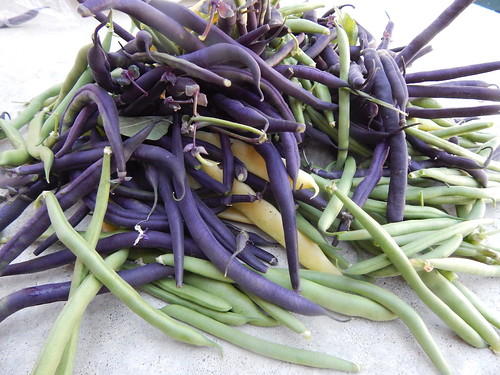 Not only are the pole beans doing well, the other varieties are producing well too. Beans are a versatile and productive vegetable, although I don’t often recommend them for a small space garden. Now I’m wondering about the pole beans again…
Not only are the pole beans doing well, the other varieties are producing well too. Beans are a versatile and productive vegetable, although I don’t often recommend them for a small space garden. Now I’m wondering about the pole beans again…
 The Mexican Blue Sage (Salvia leucantha) is finally in full, glorious bloom. It is also very attractive to our bees. When I was trying to capture some good pictures, I realized that the grasshoppers are also enjoying the plant!
The Mexican Blue Sage (Salvia leucantha) is finally in full, glorious bloom. It is also very attractive to our bees. When I was trying to capture some good pictures, I realized that the grasshoppers are also enjoying the plant!
Have a great weekend!
Friday PhotoEssay – September 18, 2015
The garden continues its downhill trend for the fall. The tomatoes may still have some green fruit on them, but I’ll be honest that they have reached the stage of ugly where I just want to yank them out. We harvested quite a bit of squash this week and planted some late spinach seed for the fall. 
Our last Saturday Sampler of the year is tomorrow, and we’ve been busy in the kitchen chopping and prepping some of the squash from the garden. We estimated that we have at least 15-20 cups of cooked squash right now. Yikes! Come out to the Demo Garden at 9 a.m. on Saturday, Sept. 19th to learn more about growing and cooking winter squashes.
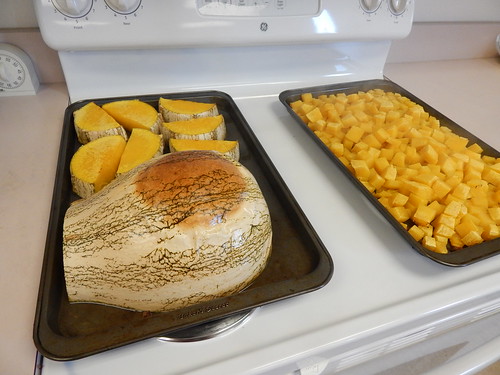
This is just a portion of the Green Striped Cushaw. It is really tasty! It is always a good start when the vegetable that is insect and disease resistant is also flavorful. The cushaw has a nice yellow flesh.
 This is one of the ‘Fairy’ squash that has a much more orange colored flesh. We haven’t cooked it yet to compare flavors. SPOILER ALERT! We’re making this one into chili for Saturday.
This is one of the ‘Fairy’ squash that has a much more orange colored flesh. We haven’t cooked it yet to compare flavors. SPOILER ALERT! We’re making this one into chili for Saturday.
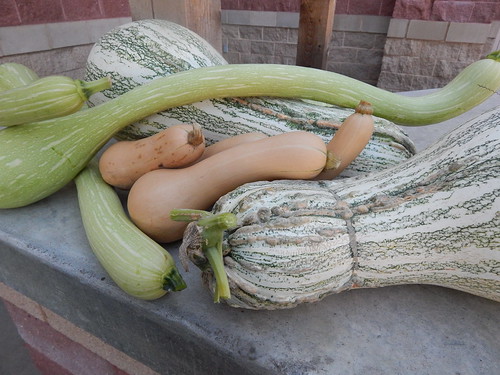 I guess we’re going backwards in time here. This is our “haul” from the garden this week. We harvested a bunch of butternut squashes, some tromboncino, and a couple more cushaws.
I guess we’re going backwards in time here. This is our “haul” from the garden this week. We harvested a bunch of butternut squashes, some tromboncino, and a couple more cushaws.
 Some of the lettuce survived the caterpillar onslaught and some didn’t. This plant survived, only to have a grasshopper hanging out in the center on Monday morning. If it isn’t one thing, it’s another!
Some of the lettuce survived the caterpillar onslaught and some didn’t. This plant survived, only to have a grasshopper hanging out in the center on Monday morning. If it isn’t one thing, it’s another!
 Sorry…I just had to break out a Swiss Chard photo to end the week. We’ve let it go for a couple weeks and it has gotten bigger quickly. It is one of the few things in the garden that is still looking spectacular!
Sorry…I just had to break out a Swiss Chard photo to end the week. We’ve let it go for a couple weeks and it has gotten bigger quickly. It is one of the few things in the garden that is still looking spectacular!
Have a great weekend!
Friday PhotoEssay – September 11, 2015
The Demo Garden has an Instagram account! Check us out @thedemogarden on Instagram. You can see a few pictures on a more regular basis.
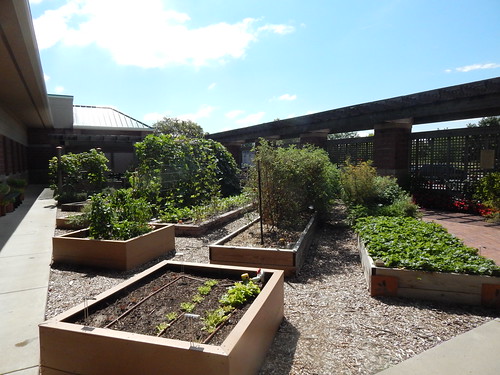 The garden is still looking good after the rain this week. That said, on close inspection a lot of the plants are looking tired, so don’t feel bad if your garden isn’t perfectly beautiful anymore. The lovely lettuce in the close bed is looking a little bit skimpy today, and you will see why in the next picture.
The garden is still looking good after the rain this week. That said, on close inspection a lot of the plants are looking tired, so don’t feel bad if your garden isn’t perfectly beautiful anymore. The lovely lettuce in the close bed is looking a little bit skimpy today, and you will see why in the next picture.
 The nice thing about growing red lettuce is that the green caterpillars show up really well. They have been having quite the feast on the lettuce, because it has gone from looking lush to munched in just two days. I had to go out and buy an insecticide this afternoon, because I was pretty sure the lettuce would have been dead by Monday.
The nice thing about growing red lettuce is that the green caterpillars show up really well. They have been having quite the feast on the lettuce, because it has gone from looking lush to munched in just two days. I had to go out and buy an insecticide this afternoon, because I was pretty sure the lettuce would have been dead by Monday.
When you are dealing with caterpillars, my preference is to use one of two organic products: spinosad or Bt (Bacillus thuringiensis) dust. Because we only have a small area planted to lettuce, I bought a ready-to-use spinosad spray. Hopefully the lettuce is strong enough to put on new growth from the roots for this fall.
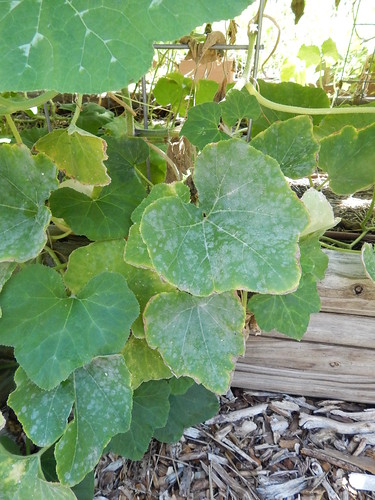 Since we are on the “death and destruction” theme today, I noticed that most of the leaves that had powdery mildew are gone (dead) since last week, although there are a few (like this one) still showing symptoms. I’m not 100% sure which variety is the susceptible one, but I rather suspect it is the ‘Butterpie.’
Since we are on the “death and destruction” theme today, I noticed that most of the leaves that had powdery mildew are gone (dead) since last week, although there are a few (like this one) still showing symptoms. I’m not 100% sure which variety is the susceptible one, but I rather suspect it is the ‘Butterpie.’
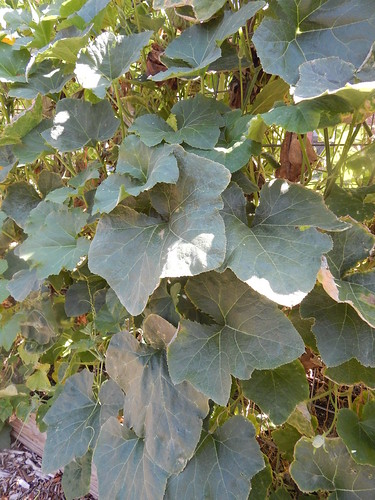 I know it is hard to tell because of the light, but most of the rest of the vines, including this one have huge, healthy green leaves. No sign of powdery mildew! I’m glad we have some great resistant varieties, I’m just bummed that I’m not sure which variety is which.
I know it is hard to tell because of the light, but most of the rest of the vines, including this one have huge, healthy green leaves. No sign of powdery mildew! I’m glad we have some great resistant varieties, I’m just bummed that I’m not sure which variety is which.
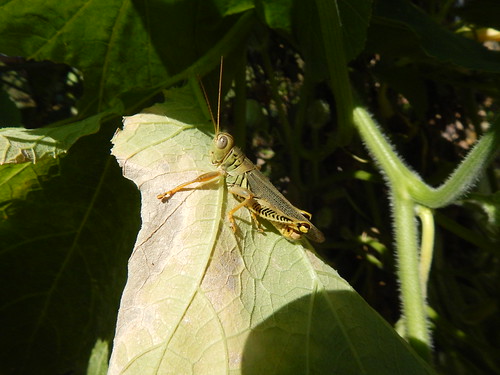 This time of year it is very common to see some big, crunchy grasshoppers. Here in town, they usually are around but not a huge problem like they can be in more rural areas. I think they are very attractive and photogenic – when there’s just a few of them. They can be huge at this time of year! They are not easy to kill right now, other than by smashing, so unless you have a major infestation, don’t bother trying to spray anything.
This time of year it is very common to see some big, crunchy grasshoppers. Here in town, they usually are around but not a huge problem like they can be in more rural areas. I think they are very attractive and photogenic – when there’s just a few of them. They can be huge at this time of year! They are not easy to kill right now, other than by smashing, so unless you have a major infestation, don’t bother trying to spray anything.
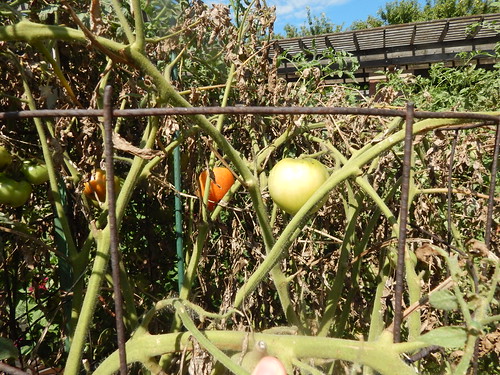 If your tomatoes look awful, don’t worry! Ours do to. It is natural for this time of year. They are working on ripening the last flush of tomatoes as we move into the cooler parts of fall. Incidentally, this picture is the ‘Beefy Boy’ which I gave a generally favorable review to earlier in the summer. I finally had a chance to taste one, and it is quite good. That means a lot, coming from someone who doesn’t generally care for red tomatoes!
If your tomatoes look awful, don’t worry! Ours do to. It is natural for this time of year. They are working on ripening the last flush of tomatoes as we move into the cooler parts of fall. Incidentally, this picture is the ‘Beefy Boy’ which I gave a generally favorable review to earlier in the summer. I finally had a chance to taste one, and it is quite good. That means a lot, coming from someone who doesn’t generally care for red tomatoes!
Have a great weekend!




